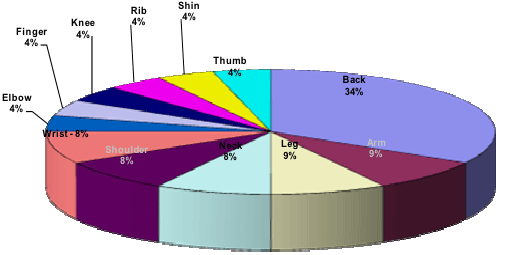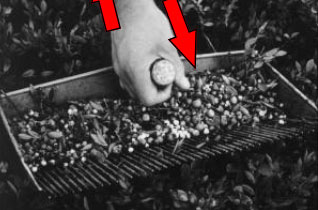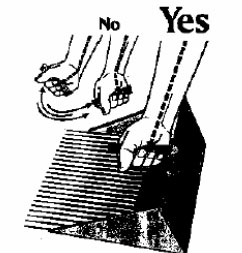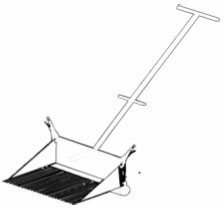Muscle Strain
The Blueberry Workplace
Muscle Strain Injuries – Most Frequent Work-related Injury
Although harvesters are engaged in blueberry harvesting, their health is affected by all of the practices performed on blueberry farms.
- While raking, harvesters may work in wet environments, may work around nets, and may come into contact with natural irritants and chemicals.
Contributing Factors and Parts of the Body
Contributing Factors of Muscle Strain Injuries:

Part of Body with Muscle Strain Diagnoses:

Contributing Factors of Back, Neck and Knee Muscle Strain
27% of reported muscle strain pain in the back; 3% in the knee
Severe flexion – 90° trunk angle

Back, neck and knee muscle strain
- A blueberry harvester maintains the awkward posture shown above for the majority of the day.
- He only leaves this awkward posture when he carries the filled buckets—which can weigh 26kg on some farms, exceeding the NIOSH recommendation of 21kg—to the edge of his picking zone.
- For the majority of the day, his time is spent in severe flexion with a 90° trunk angle, shown above.
- More muscle strain is added to the legs and knees as one or two legs are usually bent.
- Some workers who only rake with one hand will relieve discomfort by placing non-raking hand on corresponding knee.
Contributing Factors of Wrist, Hand and Elbow Muscle Strain
20% of reported pain of blueberry workers occurred in the wrist/hand; 11% in the elbow.
- The rakes used in lowbush blueberry harvesting are made of steel or aluminum
- Rakes have an average weight of 1.7kg
- Continuous static power grip is maintained on handle
- The amount of force required to pull the rake through the berries is about 9kg.

“Rakers’ wrist”
- Rakers generally move their wrist in the radial and ulnar direction while raking blueberries.
- Shown above, the wrist is ulnarly deviated when the rake is being placed under the bushes.
- As the rake is pulled through the bush, the wrist is deviated in the radial direction.
- The range of movement of the wrist is anywhere between 15 and 45 degrees.
- Workers average 32 raking cycles per minute (once every two seconds)
- This severe and repetitive wrist deviation is one of the main contributors to wrist pain in rakers.
- In a few cases, symptoms and clinical findings are consistent with Carpal tunnel or de Quervain’s disease
- A few workers rely more on elbow and shoulder movement than wrist motion in order to alleviate pain.

Possible Improvements
Suggest to the Farmworker:
- Add diameter to the rake handle to make it the right size for the harvester (use pipe foam, electrical tape etc)
- Add a handle to each side so that it can be used with both hands. One hand is on the center handle, and the other is on one of the other two handles instead of using a “pinch grip” to guide the rake
- Switch hands often
- Don’t wait too long to empty rakes
- Encourage harvester to keep wrist straight while raking, not move side to side


Speak to farmowner about the use of roller rakes
These rakes tend to be somewhat heavier, but take the muscle strain off the lower back. The other disadvantage of the roller rake is that it is difficult to maneuver on uneven surfaces.
Cost: $300 (17-30 hours of wages, but lasts for several years)
Manufactured by:
Acadian Mountain Works
902-882-2349